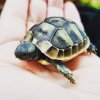Eklayre
New Member
- Joined
- Mar 10, 2017
- Messages
- 18
Hi there! We just brought home our new little guy/gal on Tuesday, he's (going to say he, for now) a 3 month old Hermann's, under 2", and fiesty, active, and more than we'd hoped for! Got him from a well regarded locally owned pet store that we love. They've been very helpful, and their totoise/turtle expert helped us get a temporary glass set up put together while we build our enclosure and he gets bigger.
Lighting and temp are good, he's feeding daily (and pooping, yay!), and we're soaking him daily for 10-15 min, he really seems to enjoy it. I have a temp gun along with the temp and humidity gauge inside the tank, am paying close attention.
My big issue is they were adamant that we use hay only as a substrate, no coco coir, or soil/sand, as they claimed it was best to not get too humid and that hay was safest and wouldn't irritate him. We also have along clumps of wet spagnuhm moss (and a humid hide he like to climb on, but not go in), a few slate rocks, and a good/water shallow dish. I did a bunch of reading prior to purchase, but to be honest we were looking at Russian tortoises, so the decision to get a Herman's came after meeting the hatchlings. We picked the most active, we just fell in love with his little personality, which was apparent at the pet shop as well.
Anyway - he seems to be doing great and loves burrowing in the hay. That's what the pet store used, so I'm sure it's what he's used to. He climbs and explores and is very active until mid afternoon, when he burrows in and settles down to chill and then sleep. I'm just worried it's not humid enough, and the hay has been bugging me. Humidity has been around 45-50 daytime, and 70 before we go to bed when I check.
I read such conflicting advise from both books and online. What are your thoughts???
Thank you so much!!! Sorry this is so long, I just want to make sure we do all we can to ensure he's healthy and happy. Pics to follow if it can figure it out from my phone
-Claire
Lighting and temp are good, he's feeding daily (and pooping, yay!), and we're soaking him daily for 10-15 min, he really seems to enjoy it. I have a temp gun along with the temp and humidity gauge inside the tank, am paying close attention.
My big issue is they were adamant that we use hay only as a substrate, no coco coir, or soil/sand, as they claimed it was best to not get too humid and that hay was safest and wouldn't irritate him. We also have along clumps of wet spagnuhm moss (and a humid hide he like to climb on, but not go in), a few slate rocks, and a good/water shallow dish. I did a bunch of reading prior to purchase, but to be honest we were looking at Russian tortoises, so the decision to get a Herman's came after meeting the hatchlings. We picked the most active, we just fell in love with his little personality, which was apparent at the pet shop as well.
Anyway - he seems to be doing great and loves burrowing in the hay. That's what the pet store used, so I'm sure it's what he's used to. He climbs and explores and is very active until mid afternoon, when he burrows in and settles down to chill and then sleep. I'm just worried it's not humid enough, and the hay has been bugging me. Humidity has been around 45-50 daytime, and 70 before we go to bed when I check.
I read such conflicting advise from both books and online. What are your thoughts???
Thank you so much!!! Sorry this is so long, I just want to make sure we do all we can to ensure he's healthy and happy. Pics to follow if it can figure it out from my phone
-Claire







